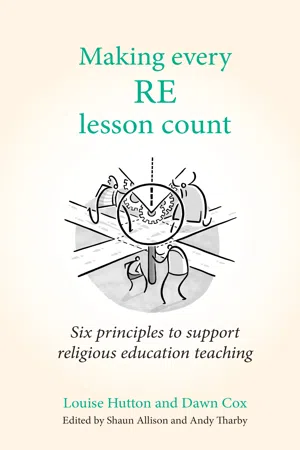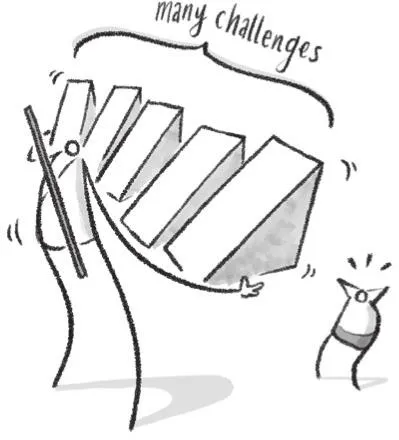Ali is in Year 9. While copying out a diagram of a synagogue, he swings on his chair, looks at his teacher with sullen eyes and says, ‘Miss, this is SO boring – RE stands for REally boring. Why do we have to learn it? I’m not religious, and I’m never going to be a priest.’ While she wants to reply, ‘You’re not a volcano either and you still have to study them in geography’ or, ‘It’s the law – take it up with the education secretary’, she doesn’t. She thinks about how she can make religion more meaningful to him – perhaps in the next lesson she could shoehorn in that interview with a footballer in which he talked about why he really enjoyed RE at school?
What is Challenge and Why Does it Matter in RE?
The lack of challenge in the lesson has led Ali to question the relevance of RE to his life. The teacher assumes that because Ali thinks RE is boring that she should try to do something that makes it more relevant. However, RE becomes relevant through challenge. 16
Sometimes it is forgotten that RE is relevant to all students because it gets to the heart of what it means to be human. While classrooms in the UK are becoming more secular – with seven in ten young people saying that they have no religion – students are often surprised that 84% of the world’s population identify with a religious group. If we use the disciplines of theology, philosophy and the social sciences to structure our curriculum, then relevance comes through the students using their own lens to consider their positionality – how they fit into the landscape of the world around them.
Furthermore, Daniel Willingham highlights why searching for relevance in what we teach is mistaken:
The content we teach can be fascinating because of its difference.
Sometimes, to make it engaging, teachers try hard to make their subject relevant to what the students already know. The pre-2016 GCSE used to include topics that tried hard to do this: ‘Religion and sport’ and ‘Religion and the media’ were both very popular. Matt Pinkett and Mark Roberts 17point out the error of this in Boys Don’t Try?, in which they observe that giving boys work about football because they won’t be interested in Shakespeare encourages low expectations: ‘we are saying to boys you’re a boy, this is all you can cope with, this is all you need to know about. Watered-down curricula ensure that boys switch off after the initial sugar rush or relevancy has subsided.’
But this does not just apply to boys. Lowering the expectations of all of our students on a quest for relevance turns our wonderful subject into something more like cartoon clipart than the intricate tapestry of belief and belonging that has chartered the millennia. In some schools RE is seen as a soft subject – anything and everything goes. This might have come, in part, from the legacy of GCSE religious studies exams which credited (any) opinions with marks, as well as the views of those who assert that ‘you can’t be wrong in RE’. We dispute this.
Teachers often try to make the subject appear more relevant because they think that some of the content in RE is dry. We need to consider why this is the case:
♦ Are there abstract concepts which are difficult to explain?
♦ Does it require subject knowledge that is currently beyond that of the teacher?
♦ Does it raise questions that the teacher cannot answer?
♦ Does it include content that teachers feel doesn’t really belong in RE?
♦ Is it that teachers don’t think students will ever use it again in their life?
♦ Is there a lack of resources to present it in different ways?
Certainly, the more recent religious studies GCSE is far more challenging. It contains more theological concepts and 18insists that students are able to understand the beliefs, teachings and practices of a religion in more depth, alongside what has been traditionally thought of as engaging RE – those thematic ideas of applied ethics taught in ‘Religion and life’ or ‘Peace and conflict’. Our challenge as teachers is to be aware of those things that we find most difficult to teach well and to turn it into something that is intellectually engaging and, in turn, challenging for the students.
If the curriculum is weak then it will fail to challenge students, and so curriculum design is important.
Curriculum Design
At Key Stages 3–5, we will follow the agreed syllabus that the school has chosen or is determined by the local authority for core RE, and at Key Stages 4 and 5 we will obviously follow the GCSE and A level specification. These parameters will guide what you teach by giving you the broad headings – for example, the syllabus may include the six main religions or outline that you should teach a number of religions at Key Stage 3. Conversely, it may give topic titles or key questions that you should consider over time, such as ‘Is social justice possible?’ An agreed syllabus or specification is not a curriculum; it is what we do with it that turns it into a curriculum. Curriculum design is the process of deciding the what, why and when of the content that we teach based on these documents.
There are two key elements that we need to consider: content and sequencing. While the syllabus sets out what content needs to be covered, the specifics surrounding what we choose to teach from these broad headings will be far more precise. Sequencing refers to the coherent and logical order in which we organise the content. We will consider these two elements in more detail in the pages that follow. We should think hard about the curriculum because it is a model 19of progress for the development of our students’ knowledge and understanding over time. Michael Fordham explains that ‘a curriculum sets out the journey that someone needs to go on to get better at the subject’. But a curriculum is never finished. It should be an ongoing process of reflection, adaptation and development.
Content
The RE domain is huge and we cannot teach it all, so we need to make strategic decisions ...




